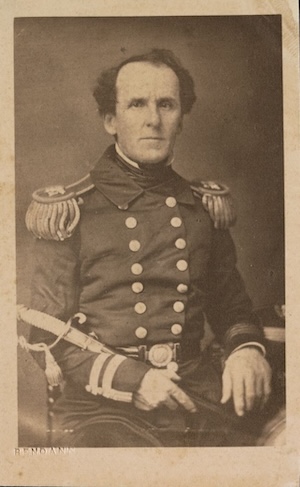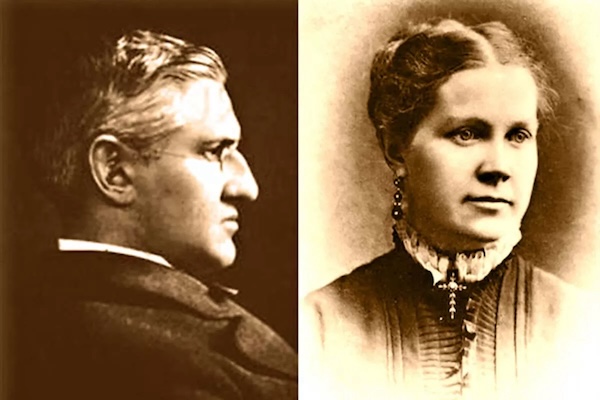A photograph of Gen. Lewis Cass taken by Mathew Brady, circa 1860-65. In 1837, Cass dropped the anchor of the USS Constitution off Jaffa. (photo from US National Archives and Records Administration)
President Donald Trump’s unconventional proposal on Feb. 5 to annex the Gaza Strip isn’t the first time the United States has expressed territorial ambitions in the Middle East.
In 1837, Gen. Lewis Cass (1782-1866) dropped the anchor of the USS Constitution, “Old Ironsides,” off Jaffa. (Until British dynamite cleared the rock-strewn harbour in the 1920s, rowboats connected the port with the ships anchored offshore.) Together with several US Navy officers, Cass proceeded inland, planning to survey the uncharted Dead Sea – the lowest point on earth – but the poorly equipped mission was a failure. Ill from sunstroke and dehydration, the sailors barely managed to return to their vessel alive.
A decade later, Lieut. William Francis Lynch (1801-1865) of the US Navy led a better-provisioned 17-man expedition to explore the Jordan River and Dead Sea. Camels hauled the prefabricated boats specially manufactured of copper and galvanized iron overland from the Mediterranean Sea to Lake Kinneret (Sea of Galilee). Lynch then ventured down the Jordan River, which is a creek by most standards. In tandem, a party proceeded on land. The mission mapped the Jordan’s hitherto unknown 27 rapids and cascades. Though it is only 100 kilometres from the freshwater Lake Kinneret to the Dead Sea, the Jordan River’s winding course was 322 kilometres long. Lynch described the Jordan as unsuitable for navigation, calling it “more sinuous even than the Mississippi.”

While advancing “the cause of science,” Lynch was also at “the service of American commerce with the region.” He reported “an extensive plain, luxuriant in vegetation and presenting … a richness of alluvial soil, the produce of which, with proper agriculture, might nourish a vast population.”
While Congress shelved Lynch’s report recommending colonization, it helped spark the United States’s fascination with the Holy Land – and led to the establishment of American colonization projects in Jaffa and Jerusalem.
At Tel Aviv’s south end is a cluster of wooden clapboard buildings straight out of New England known as the American Colony. The story begins shortly after the American Civil War: on Aug. 11, 1866, 157 members of the Palestine Emigration Colony – including 48 children under the age of 12 – set sail from Jonesport, Me., for Jaffa on the newly built, three-masted vessel USS Nellie Chapin.
George Jones Adams (1811-1880), leader of the 35 New England families, hoped to develop the Land of Israel in preparation for the biblically prophesized return of the Jews. This would hasten the second coming of the Christian messiah. Adams had been a follower of the Mormon Church, but quit the religion following the assassination of Mormon founder Joseph Smith in 1844. Most of the congregants of the Church of the Messiah that Adams founded lived in Maine.
Departing the United States, Adams stated: “We believe the time has come for Israel to gather home from their long dispersion to the land of their fathers. We are going [to Jaffa] to become practical benefactors of the land and people, to take the lead in developing its great resources.”
Proto-Zionists, their purpose was not to missionize but to assist the Jewish people in returning to their ancestral land. However, though equipped with the latest agricultural tools, 22 pre-fab houses and religious fervour, the colonists’ mission was doomed. Arriving in Jaffa, they learned that Adams had not yet purchased the land on which they planned to settle. Instead, they pitched their tents on the beach near a cemetery where the victims of a recent cholera epidemic were buried. Within six months, 22 of the 157 settlers, including nine children, were dead.
Disease was not the settlers’ only problem. After finally buying the property for their neighbourhood, the first outside of Jaffa’s Ottoman ramparts – Tel Aviv would only be founded 43 years later, in 1909 – the pioneers quickly learned that farming in the arid Middle East was nothing like agriculture in rainy New England.
Facing starvation and soaring mortality, Adams sought solace in alcohol. Within two years after their arrival, all but two dozen or so members of the American Colony had returned to the New World. Their buildings were sold to newly arrived German evangelical Christians. Known as Templars, the Germans developed seven colonies across Palestine until being arrested by the British in 1939 as Nazi sympathizers. They were deported to Australia or sent back to the Third Reich in prisoner exchanges.
Among the Americans who remained was Rolla Floyd (1832-1911), a pioneer of Israel’s tourism business. In 1869, he opened the stagecoach service from Jaffa to Jerusalem on the newly paved road. The journey from the coast to the mountains took 14 hours: today’s high-speed train covers the same distance in 29 minutes, with a stop at Ben-Gurion Airport.
The Maine settlers were not forgotten, thanks to Reed Holmes: in 1942, the historian met an elderly woman who had been 13 when the Nellie Chapin dropped anchor. After four decades of research, Holmes published The ForeRunners. Around the same time, he organized a tour of Israel. Among the participants was Jean Carter, a licensed contractor from Massachusetts. Touring the former American Colony, she was aghast to learn that the decrepit, historic wooden houses were about to be torn down.
Raised in a Protestant church, Carter had a master’s degree in Jewish studies and was fluent in Hebrew. She persuaded the Israeli government to declare the former colony a heritage site, received a promise that any structure that could be preserved would be spared demolition, and got the Tel Aviv municipality to erect a plaque on the beach where the Maine colonists had landed.
Holmes and Carter fell in love and eventually married. In 2002, they purchased Wentworth House – one of the remaining American Colony buildings. With the help of specialists in 19th-century building preservation techniques from Maine, the couple spent two years restoring the ruin and removing later additions. Today restored as the Maine Friendship House, it houses a museum about Jaffa’s American Colony.
The Holmes, who live in Peace Valley, Me., were honoured in 2004 by the Maine Preservation Society – the first time the group recognized a project outside of New England.
Unrelated to Jaffa’s American Colony is a Jerusalem settlement of the same name. The eponymous luxury hotel where foreign journalists like to belly up to the bar was founded in 1881 as a commune – Israel’s first kibbutz – by members of a Protestant utopian society led by Horatio Spafford of Chicago (1828-1888), who penned the Evangelical hymn “It Is Well With My Soul.”
Spafford and his wife Anna (1842-1923), together with a group of 14 adults and five children, expected Jesus’s second coming imminently. While waiting, the members of the pietistic settlement of Yankees and Scandinavians served the Holy City’s many destitute by opening soup kitchens, hospitals, orphanages and other charitable ventures.

Much of that charity was funded by the American Colony Photo Department, which became the community’s primary income. Many of those early images fall into the category of Orientalism, for which the West had a seemingly insatiable appetite. But part of that artistic achievement was due to fortuitous timing – the colony’s photographers began operating at a time when tourism to the Holy Land, especially from America and Europe, was beginning en masse.
Moreover, “with the advent of halftone printing in the 1880s, images were now becoming more accessible to the public via printed matter – books, magazines and newspapers – where they were now reproduced alongside text,” notes Tom Powers in his 2009 work Jerusalem’s American Colony and Its Photographic Legacy. (Before that, photographs could only be pasted into books by hand, as individual prints.)
A third factor was getting off to a good start, thanks to plain luck. The first sizeable project of the American Colony documentarians was the1898 state visit of Imperial Germany’s Kaiser Wilhelm II and Empress Augusta Victoria to the Holy Land.
Interested in seeing the American Colony Photo Department’s 22,000 historic photographs archived at the Library of Congress in Washington, DC? Visit loc.gov/pictures/collection/matpc/colony.html.
Gil Zohar is a writer and tour guide in Jerusalem.

